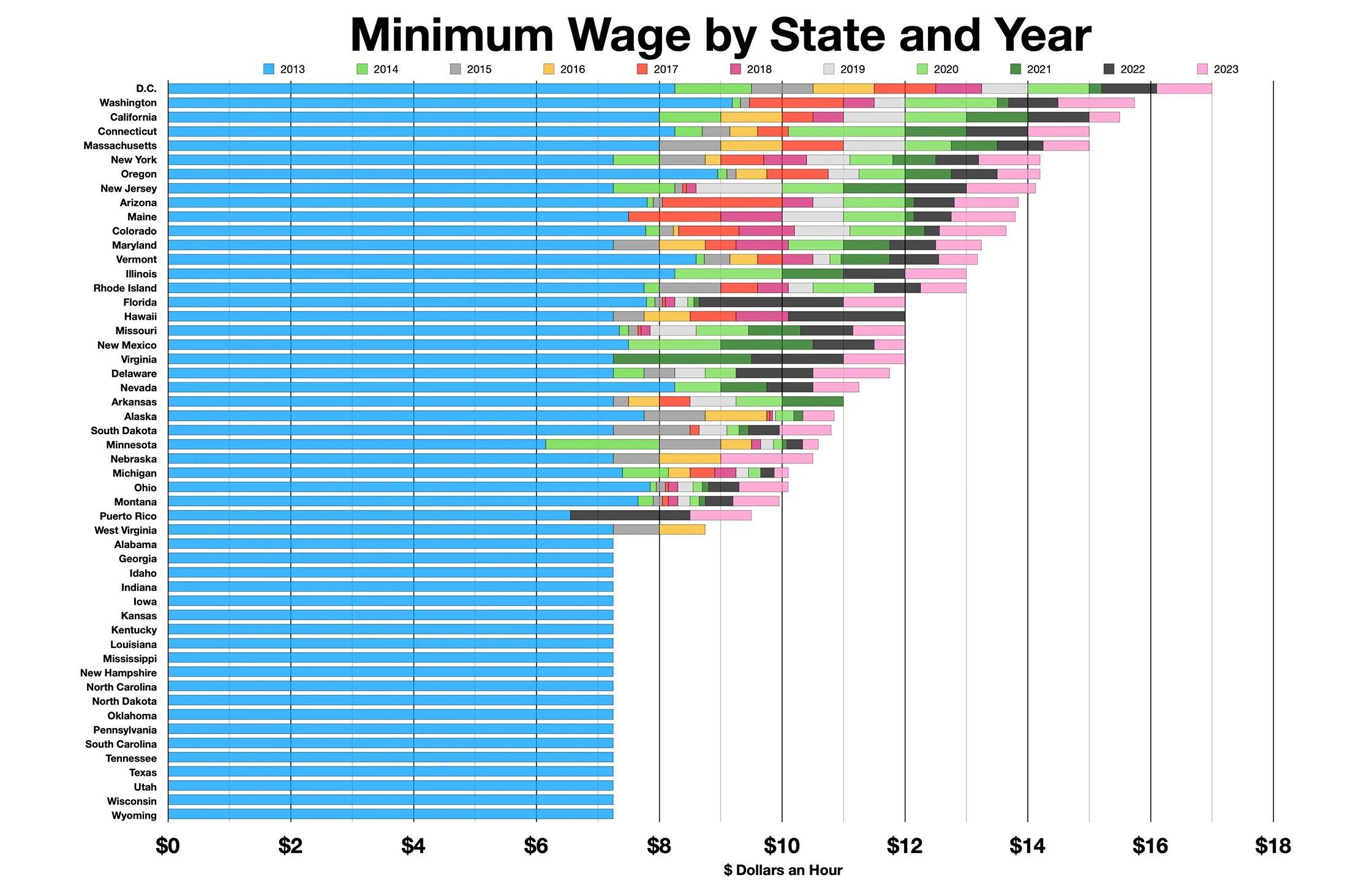A key priority of most Democrats is reducing the income inequality that has drastically increased since the Reagan Revolution in the 1980s. As noted in the December issue of Tumbleweird, income inequality slows economic growth, produces higher rates of health and social problems, and lower rates of social goods such as life expectancy, trust among strangers, and social mobility. But what can be done to reverse it?
John Powell wrote a prescription for reducing income inequality in 2014: 1) increase the minimum wage, 2) expand the Earned Income Tax Credit, 3) build assets for working families, 4) invest in education, 5) make the tax code more progressive, and 6) end residential segregation.
One of these suggestions has been embraced, at least in some states and cities. While the federal minimum wage remains at $7.25 per hour, it is $15.74 per hour in Washington state (the highest in the nation) and $16.50–$18.69 per hour in Seattle.
In a reversal of the trend for the last thirty years, income inequality in the U.S. decreased in 2022. Patricia Buckley and Akrur Barua show that wages for low-wage occupations have indeed risen faster than for high-wage occupations during the last few years. Why? Buckley and Barua attribute the rise to a reduced supply of low-wage workers, but they don’t even mention increases in minimum wage. Minimum wage has risen dramatically in about half of the U.S. states since 2013. It seems likely that much of the recent wage rise for low-wage workers is due to the increasing minimum wage in progressive states. A state-by-state analysis is needed to confirm this.
The recent rise of the power and impact of unions such as the United Auto Workers could also be a factor but, since most of the new agreements are within the last year, the impact won’t show up in national data for at least another year. It will mostly impact the wages of middle-wage jobs. Of course, the unions wouldn’t have traction if there wasn’t demand for their labor.
The minimum wage has increased substantially in most states, but what about the other actions on Powell’s list? The federal response to the pandemic offers an interesting experiment. It included a large distribution of cash to people experiencing poverty through stimulus checks, increased food stamps, and expanded unemployment insurance. This aid is similar to a large Earned Income Tax Credit. The Urban Institute estimates the aid reduced the poverty rate for Americans from 13.9% to 7.7%.
The Secure 2.0 Act of 2022 makes 401(k) automatic enrollment mandatory for new 401(k) plans. Employees can still opt out, but the Act is expected to increase enrollment, thereby building the assets of working families.
Pre-K education is known to boost high school graduation rates and career earnings. The percentage of 4-year-olds enrolled in pre-K education varies widely, from 0% in Idaho and Wyoming to 84% in Washington D.C. To reduce this range, President Biden is calling for universal pre-K education.
Contrary to conventional wisdom, the Tax Cuts and Jobs Act passed in 2018 is progressive, as the share of taxes paid by the top 1% subsequently increased while the share of the bottom 50% decreased. While the act decreased the tax rate for the highest income bracket, it also doubled the standard deduction and expanded tax credits for people living under the poverty line. However, overall tax revenue has decreased substantially, which will put pressure on future federal aid to lower-income families.
Explicit residential segregation is now illegal, but racial segregation was federal policy from the 1930s to the 1960s. Data on residential segregation shows that racial segregation has decreased substantially since 1960, but segregation by income has increased. As a result, racial segregation remains very high.
So far, I’ve considered only domestic income inequality. There are vast differences in the median incomes of the United States and most developing countries. These differences have long driven immigration from developing countries and Europe. Opposition to immigration has been based on two unfounded fears: a) immigration of unskilled workers will depress the wages of U.S. workers, and b) immigration of skilled people will displace U.S. skilled workers. The resulting resistance to immigration causes shortages of entry-level workers in agriculture and labor-intensive jobs and a diminished supply of educated professionals and entrepreneurs.
People in developing countries strive to attain the wealth that people in the U.S. enjoy. Some might argue that global greenhouse gas emissions will soar if the developing world flourishes. Indeed, greenhouse gas emissions from China have risen dramatically over the last twenty years, and are now double those from the U.S. However, a recent study concluded that extreme poverty can be eliminated globally with negligible impact on global greenhouse gas emissions. The trick is to raise the incomes of those in extreme poverty without increasing the incomes of the wealthy. That is, reducing income inequality by elevating the disadvantaged.
Minimum wage by state image created with data from minimum-wage.org/wage-by-state, laborlawcenter.com/state-minimum-wage-rates, and LiberationReport.com
Steve Ghan leads the Tri-Cities Chapter of Citizens Climate Lobby.


